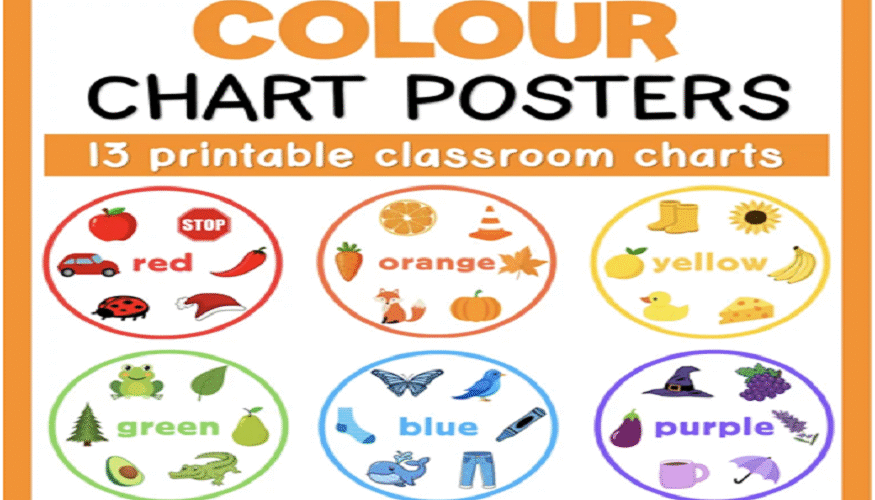Colour plays a vital role in early childhood development. Young children experience the world in a very sensory way, and colour becomes one of the most engaging and understandable tools in their learning environment. Recognising and identifying colours is more than just a fun visual activity. It contributes significantly to a child’s cognitive growth, supports their language development, and lays a foundation for future learning in literacy, numeracy, and science.
Teachers in early years classrooms use colour charts, games, and sorting activities to help children recognise, name, and categorise colours. These seemingly simple tasks build critical thinking and enhance memory skills. For young children, seeing and using colour becomes one of the earliest ways they begin to make sense of the world around them.
The Connection Between Colour Recognition and Cognitive Skills
Cognitive development in early childhood refers to how children think, explore, and figure things out. It includes the development of memory, attention, and problem-solving skills. When children learn to distinguish between red, blue, green, yellow, and other colours, they are actively using their brains to compare, sort, and classify.
These exercises strengthen a child’s ability to observe differences and similarities. This form of classification is an early math skill that prepares children for more advanced concepts later. Recognising colours also supports pattern recognition, which is a key part of early reading and math.
Teachers can integrate colours into many classroom activities. Using colour as a visual cue helps students stay engaged, follow routines, and understand instructions more easily. A child who can quickly identify that the “red” box contains building blocks and the “blue” tray holds pencils is already exercising cognitive flexibility and decision-making.
Colour and Language Development
Learning colour names expands a child’s vocabulary. It gives them new words to describe objects and express thoughts. When children point to an object and say “green ball” or “yellow flower,” they are practicing descriptive language. This improves sentence structure and communication.
Kindergarten classrooms that offer strong visual aids, like colour charts and interactive displays, support children who are still developing verbal skills. These visual supports allow non-verbal or shy students to participate more confidently.
When educators include colour-based tasks in their teacher lesson plans, they allow children to link language and experience. A lesson that asks children to “find three red objects” combines counting, observation, and vocabulary into a single activity. This is one reason colour lessons appear frequently in effective lessons plans for kindergarten.
Emotional and Social Growth Through Colour
Children often express emotions through colours before they fully understand or articulate their feelings. Using colours to talk about emotions helps young learners gain emotional intelligence. Activities like drawing “how I feel today” using colour choices allow teachers to understand and connect with their students better.
This form of expression also encourages students to reflect and talk with peers. In turn, this builds social skills like empathy and cooperation. Many kindergarten teacher resources include emotional literacy activities that use colours as a starting point for discussion.
Colour also helps with classroom behaviour. Teachers who assign different colour zones for activities—such as a green reading corner or a yellow art space—create structure and reduce confusion. This method supports cognitive control and attention regulation. It keeps students aware of their surroundings and actions, which contributes to their overall learning success.
Colour Activities That Boost Thinking
Simple and structured colour games can build brain power. Sorting games that ask children to group red items together or place all yellow toys in a bin sharpen logical thinking. Matching games with coloured cards help improve short-term memory and concentration.
Educators looking for a strong lesson plan for teachers can include activities that combine colours with fine motor skills. For example, placing coloured pom-poms into matching cups using tongs strengthens both cognitive ability and hand-eye coordination. These are valuable, hands-on experiences that help children grow in multiple ways.
Additionally, storytelling using colours engages imagination and comprehension. Asking a child to draw a story using only blue and yellow gives them a chance to think creatively while still practicing colour identification.
Using the Right Tools and Resources
Having access to the best teacher resources makes a big difference in how successfully colour is taught in early learning settings. Colour chart classroom posters, printable worksheets, and colour-themed learning kits give teachers flexible ways to introduce and reinforce concepts.
Platforms that offer comprehensive kindergarten teacher resources are valuable because they provide variety and adaptability. Every child learns differently, and a good resource bank allows teachers to switch between activities easily. This helps meet the needs of all learners in the classroom.
Teachers also benefit from websites that offer clear, ready-to-use teacher lesson plans. These plans often align with national curriculum standards and include creative colour activities that are classroom-tested. Educators who want to save time while still offering engaging instruction will find that using professional teacher resources websites enhances the overall learning experience.
Final Thoughts
Colour recognition is one of the earliest skills children develop, but its value goes far beyond naming shades. When teachers use strategic colour-based lessons and tap into strong teaching resources, they give students an excellent head start. Colour becomes more than a visual element—it turns into a cognitive tool that empowers every young learner to think, describe, and discover.

